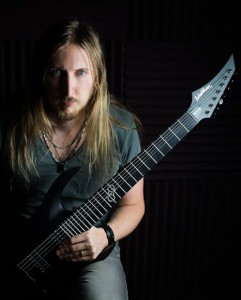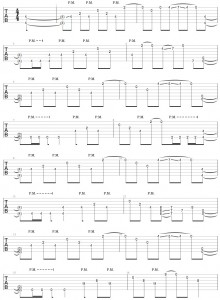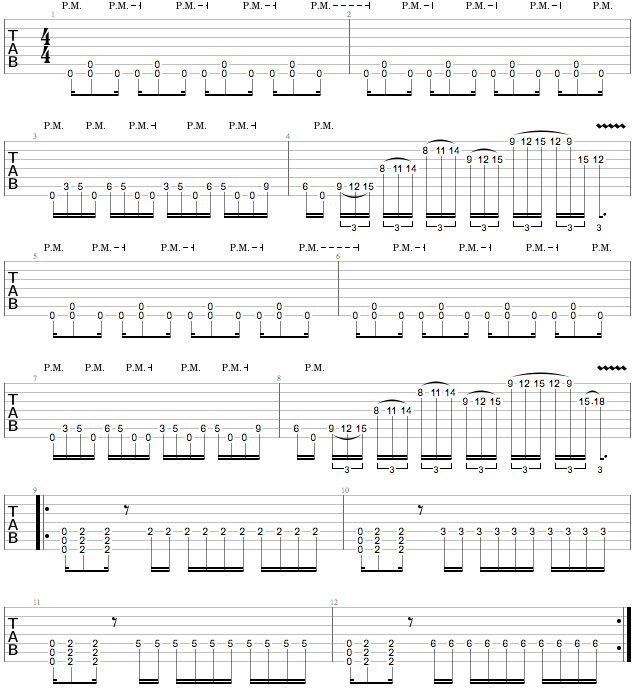In PART ONE of our interview with Ola, he opened up about building his own brand as a high-gain amp expert, playing with bands like The Haunted and living on the road. In this conclusion, Ola talks about how his tone philosophy informed the design of his new signature Randall Satan amp and Washburn Solar line of guitars, and offers some practical advice for guitarists looking to make a career in music.

IC: I’d love to talk to you about some of the new stuff that’s come out, like the [Randall] Satan amplifier. If you had to describe in a few words what you were looking for in that amp, what would they be?
OE: I wanted it to be modern, brutal as fuck, and like… brutal as fuck, again. [laughs] No, but basically I’ve been playing a lot of amps, and there’s always going to be this part where you need to make the amp sound more metal or modern. Usually you use a Tube Screamer [overdrive pedal] or something like that to boost your amp. I’m kind of sick and tired of… you’re buying a $2,000 amp and you shove a $100 pedal in front of it, in a way. When I tried a Mike Fortin Natas the first time, I was like, ‘I never played anything like this before. It’s so clear, but still so saturated.’ That was before the Randall deal, so I bought one from him and we designed one together, which we called the Satan – Fortin Satan.
That’s when Randall came along; they made me a signature model and I got a chance to go to Toronto and spend four days with Mike just designing the insides of the amp and character, tone, tone stacks… I learned so much about amps in those four days – about chokes, transformers, and we tried out all different kinds of power tubes and preamp tubes. It’s just been a super awesome experience. It really feels that I’ve had my saying in this amp and that’s why I’m so proud of it. I really love the outcome. It’s really the most brutal amp out there – right now, at least. I wouldn’t settle for less, since I’ve been trying all the amps, right?
[Click HERE to check out our NAMM 2014 feature with Randall Amplifiers, including Ola’s demo of the Satan!]
IC: So ‘brutal’ is kind of still a very broad term, though. If you can find a more specific description of what you look for… I know you like a bit more of a scooped sound – not so much a vintage-y, spongy kind of sound. Very modern, like you said.
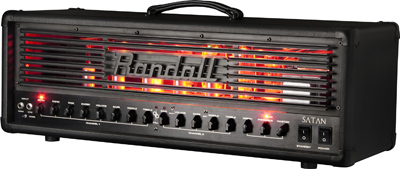
Randall Satan Amplifier
OE: Yeah, very modern, very tight. Aggressive is probably a better word than brutal. Really in-your-face hitting, with a fast attack the more you crank it. With a lot of amps you kind of lose the attack – it compresses the sound when you turn it up, but this amp stays punchy. You pull up the master volume, it gets even more in-your-face. That’s what I want, and it sounds… while it’s still aggressive and scooped, it really cuts through when playing in a band, and that’s something I’ve never had before.
I’ve played Engls. They sound awesome when you play them on your own, but when you’re live with a band, they’re gone. The [Peavey] 5150s, they really cut through really well in a mix, but I kind of still like a scooped sound. So the Satan is all about that and I’m so proud of that amp. It works so well when I play live, and it really blends well with other amps, also. It’s awesome.
IC: So it’s actually interesting: you like the scooped sound, but to cut through in a live mix – the guitar kind of lives in the mids. So you take some of that away, but you’re still heard in the mix…
OE: Right, right. I’m not meaning like really scooped, but scooped enough. A lot of people are always saying like, ‘Oh, you scoop your mids? That’s bad, and you won’t get heard when recording.’ But who the hell cares? I mean, scoop the mids. If it sounds good, who cares?
IC: If it sounds good, it is good.
OE: Yeah, exactly.
IC: What about your [Washburn Solar signature] guitar? Tell me some of the unique features of that guitar.
OE: Well, there are a couple of the Solar models from Washburn. One of them has the Evertune bridge, which is basically a bridge that keeps your guitar in tune under any circumstances. For instance, if the wood expands or shrinks; you know guitars change in different climates, and if you go from a warm backstage out to a cold festival stage, most of your guitars go flat or sharp. But the Evertune counteracts that with tension, so it stays in tune all the time. So it’s a really great innovation. I’ve never seen anything like that before, and I’m just happy that it’s something new and I think it will stay. It’s something really unique.
The guitar also has Seymour Duncan pickups, an ebony fretboard, I think alder body wood, and a maple neck. There are a couple of models out there for every wallet – I think they start from $599. The USA Custom Shop models are $3,299.
| Click play above to watch part 2 of the video for this interview. |
IC: I know you like to tune down and you use a couple of different tunings, like Drop-A. What kind of string gauges do you like to use?
OE: With Feared I play in Drop-A, that’s true. On the Solars, I’m using 25 1/2″ scale length. I’ve always been playing longer scale lengths, like 27 1/2″ and all that, but I just felt that 25 1/2″ still works for Drop-A. Right now I’m using a .64 for the low A, and it’s still really chunky. I don’t have any problems with detuning it when I pick. I think I have .09 to .64. So it’s a standard-tuned guitar with a dropped A on the seventh string.
IC: How did you come up with the name Solar for the guitar?
OE: Actually it wasn’t my idea. It was a guy called Nick Cetrone that came up with the name for the first Solar that we had with Strictly 7. I don’t know, it makes sense – my name is in there and it’s an S and an R… but yeah, it’s very neutral.
IC: The Satan is less neutral. [laughs]
OE: It’s less neutral; it’s probably more in your face. You know, I didn’t think that Randall would go with the name. But then again, I think they saw the value in it, because I did a lot of demos with the Fortin Satan before Randall came along, and a lot of people heard about the Satan like… ‘Wow, the Satan.’ So I thought that if you changed the name it would kind of remove the fact that it actually is based on the Fortin Satan. They eventually went with the name and I’m happy with that name. I mean for me Satan is just a name. I think it’s rather funny that they actually went there. It’s kind of ironic in a way. There are always going to be people that don’t like the brutality of the name, but who cares? [laughs]
IC: For a lot of people, when their hobby becomes their job, they have to find another hobby for their off-time. Is there anything you like to do in particular?
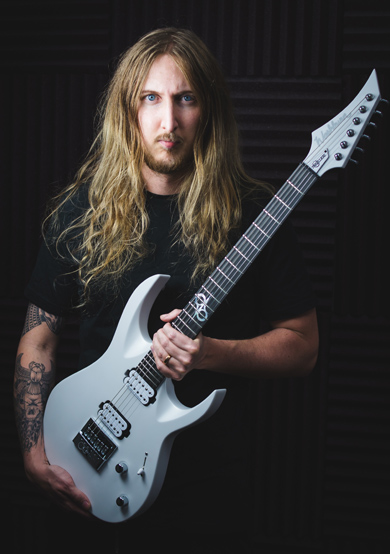
OE: When I have downtime, I like to play videogames a lot. I’m playing the Playstation 4 right now. That’s not really a hobby, it’s just something for downtime, just sitting and doing nothing. It’s perfect if you’ve been writing all day and you’re only thinking about notes and shit like that – you just go and play some videogames and it clears up your mind. You can go back, check out your riffs and see if they’re still good. That’s usually what I do.
I’m like, ‘Okay, I’m recording this awesome riff here. Yeah, it’s awesome.’ Then I go play videogames for a while – like 15 minutes, nothing more than that – go back, listen to it, ‘Oh, this riff sucks. I’d better do something else.’ I also like photography. My wife is a photographer, as well, so we like to do stuff like that. Yeah, I might have to pick up another instrument maybe as a hobby. I don’t know. Harmonica?
IC: I could see that.
OE: Yeah, me too.
IC: Pretty brutal.
OE: Yeah, pretty. [laughs]
IC: For aspiring guitarists looking to get into the industry, make their mark, and find a way to make it a living – what’s a piece of advice that you could offer them?
OE: My piece of advice would be to start yesterday. I know a lot of people are kind of anxious about releasing their own songs and having people hear them. Like, ‘Okay, I’m not really executing this video really well, I don’t really want to put it out.’ Just put it out there and get people to listen to it, before it’s too late. I mean, if you’re just hogging it to yourself, nothing’s going to happen. There are a lot of people asking, ‘How do you get famous on YouTube?’ It’s like, ‘Be the nicest guy ever.’ It’s not hard to be a nice guy. Give people compliments, help people. That’s what I like to do.
A long time ago, I went to forums and helped people with recording; like the Andy Sneap forum – I was there a lot helping people with production, and people came to me with questions and I tried to answer them as well as I could. I still do on Facebook. People send me messages asking about pickups, I try to answer as many of them as possible, and I try to really give a good answer. I think it’s really important, because word gets around and who wants to be a shitty guy? You want to be a kind guy. Give compliments, be nice, and it will work out – and also, of course, have fun while doing it.
Check out part one!
Don’t miss PART ONE of our interview with Ola, where he tells us how he built his own music career from the ground up, and this lesson, where he teaches us to play The Haunted’s ‘Eye Of The Storm!’
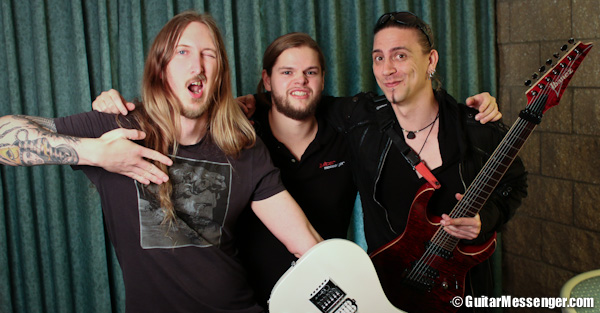
Ola Englund, Ivan Chopik, and Stéphan Forté being all wild and crazy at NAMM 2014!
[Special thanks to Chris Dingman and Alexander Pierce for their fantastic video work, and Chris’ additional editing assistance!]



